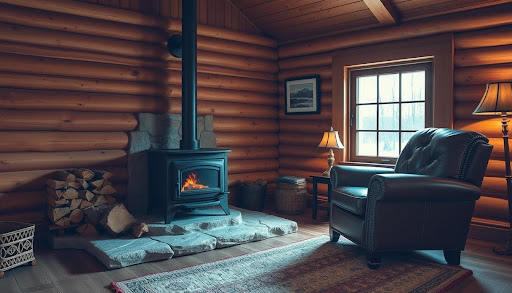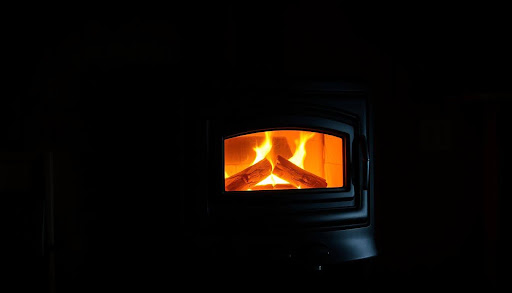Winter nights are cold and dark, making us seek warmth and comfort. Many people ask, can you leave a wood stove on overnight? It’s important to know how to safely keep a wood stove burning through the night.
To keep a wood stove burning all night, you need to prepare well and know what to do. It’s possible to have a steady heat source, but there are many things to consider to make sure it’s safe and works well for you.
Wood stoves are great for heating your home if used right. If you want warmth all night, you must follow important safety rules. You also need to choose the right wood and keep your stove in good shape.
This guide will cover everything you need to know about using your wood stove at night. We’ll talk about safety, best practices, and the risks of burning wood all night.
Whether you’re experienced with wood stoves or new to them, knowing how to use them at night is key. It helps you make smart choices about heating your home.
Understanding Wood Stove Safety Basics


Using a wood stove at night needs careful safety steps. The first thing is to make sure it’s installed right. It must follow local codes and the maker’s rules to avoid risks when burning for a long time.
Choosing the right fire logs is key to safe use. Not all wood is the same. Hardwoods like oak and maple burn well and don’t make too much creosote. When you plan to burn wood all night, picking the right logs is crucial for a safe fire.
Don’t forget about regular upkeep. Getting a pro to check your stove every year is important. They can spot problems early and check if everything is working right. Also, clean your stove and chimney often to stop creosote buildup.
Knowing how your wood stove works is important. Each model has its own needs. Reading the maker’s instructions is a must for safe overnight burning. Some stoves are better for long burns than others, so it’s good to know what yours can handle.
Safety isn’t just about the stove. Make sure it’s far from things that can catch fire. Have smoke and carbon monoxide detectors, and keep a fire extinguisher handy. These are basic steps every wood stove user should take.
The Risks of Leaving a Wood Stove on Overnight
Leaving a wood stove on overnight can be very dangerous. One big risk is carbon monoxide buildup. This gas is colorless and odorless, and it can quickly fill a room, harming people who are asleep.
Chimney fires are another big worry. Creosote inside the chimney can catch fire, causing flames that can spread fast. Old stoves or ones not well-maintained are more likely to have these problems.
Overheating is also a risk. Stoves can get too hot if they burn all night without someone watching. This can damage the stove and the house around it, leading to fires or harm to the structure.
Experts say it’s not safe to leave a wood stove on at night without the right tools and care. You should get safety gear like temperature monitors and carbon monoxide detectors. Also, use fire-resistant materials to keep your home safe.
Knowing about these dangers helps you make smart choices about using your wood stove at night. It’s important to always watch it, keep it in good shape, and follow safety rules for heating your home.
Benefits of Keeping Your Wood Stove Going Through the Night
Keeping your wood stove burning all night has many benefits. Fire logs help your stove burn longer, keeping your home warm. This way, you don’t have to worry about it all night.
Using a wood stove at night is also good for saving energy. High-quality fire logs burn slowly, so you don’t need to add more wood often. This saves time and money on heating costs.
Even when the flames go out, a wood stove keeps giving off heat. This means your home stays warm for hours. Choosing the right fire logs and burning them correctly can make your home cozy and warm.
People living in rural or cold areas really benefit from this. It’s a reliable way to heat your home, even when the power is out. With the right preparation, using your wood stove at night can be safe and effective.
Proper Wood Selection for Overnight Burning
Choosing the right wood is key for a safe, effective overnight wood stove burn. Not all firewood is created equal for long, slow burns. Hardwoods like oak, maple, and ash are best for long heating because they burn slowly and keep the heat steady all night.
UK fire logs are popular among wood stove users for their reliable performance. Lekto Wood Fuels offers premium wood fuel options for overnight burning. These logs provide a dense, long-lasting heat source that keeps your space warm for hours.
When picking wood for overnight burning, look for logs with moisture under 20%. Seasoned hardwood logs from trusted suppliers like Lekto Wood Fuels burn efficiently. Kiln-dried logs are especially good, offering a clean, steady burn with less smoke and more heat.
Avoid softwoods like pine, as they burn fast and can cause too much creosote buildup. Instead, choose dense, dry hardwoods for a steady temperature all night. High-quality uk fire logs can greatly improve your wood stove’s performance and safety.
Best Practices for Wood Stove on Overnight Operation
Thinking about leaving a wood stove on overnight? It’s important to prepare well for safe and efficient heating. The first step is to pick the right fuel and manage your fire wisely.
Start by choosing seasoned hardwood with low moisture. Hardwoods like oak and maple burn slowly and steadily. They’re perfect for heating all night. Make a solid bed of hot coals before adding bigger logs. This keeps the temperature steady all night.
Controlling the damper is key for overnight heating. Close it a bit to slow down the burn. This makes your fire last longer and saves heat.
Safety is top priority when using a wood stove at night. Make sure you have carbon monoxide detectors nearby. Always use a fire screen and keep flammable stuff away. Check your fire often and never leave it alone.
Keeping your wood stove in good shape is crucial for safe use at night. Clean it and the chimney often, check for damage, and make sure everything works right. These steps will help you have a warm and safe night with your wood stove.
Essential Safety Equipment and Monitoring Systems
Running a wood stove overnight requires top safety measures. Important monitoring systems help keep your home and family safe. Carbon monoxide detectors are key, alerting you to dangerous gas levels.
Smoke alarms are also vital. They warn of fire dangers when burning fire logs. Modern smoke detectors can alert the whole house, speeding up emergency responses.
Temperature monitoring tools add extra safety. Digital thermometers and heat sensors track stove temperatures, avoiding overheating and fires. Some systems even send alerts to your phone, letting you monitor your stove from afar.
While safety equipment might cost more, it’s worth it for the safety it offers. Make sure to test and maintain these devices regularly. Getting them installed by a pro and having yearly checks can make your home even safer.
Step-by-Step Guide to Setting Up Your Stove for Night Burning
Getting your wood stove ready for an overnight burn needs careful planning. When you think about leaving a wood stove on overnight, safety and setup are key. Start by picking high-quality UK fire logs for consistent, long-lasting heat.
First, clean out your stove. Remove old ash, leaving a thin layer for insulation. Open the air intake fully to start a hot fire. Choose dense, dry hardwood logs that burn slowly and steadily.
Arrange the logs carefully, leaving space for airflow. This helps the fire burn slowly and steadily all night. UK fire logs are great for this.
After the fire is strong, reduce the air intake slowly. Place bigger logs at the bottom and smaller ones on top. This creates a tight wood arrangement for slow, controlled burning.
Check your stove’s damper settings. Close it a bit to keep the fire burning longer. Use a thermometer to check the internal temperature. Make sure your stove is away from flammable things and smoke detectors work.
Remember, leaving a wood stove on overnight depends on good preparation, quality fuel, and safety. Always have a fire extinguisher nearby and never leave the stove alone.
Common Mistakes to Avoid When Running Your Stove Overnight
Running a wood stove overnight needs careful attention to avoid hazards. Many homeowners make mistakes that can harm safety and stove performance. One big error is putting too much wood in the stove. This can lead to dangerous conditions and lower efficiency.
Choosing the right fuel is key for overnight wood stove use. Lekto wood fuels are a better choice than random firewood. They offer consistent burn quality and lower the risk of sudden fires. Wet or unseasoned wood causes too much smoke, builds up creosote, and can damage your stove.
Setting the damper wrong can cause big problems at night. A damper that’s too closed can lead to incomplete burning and dangerous carbon monoxide. On the other hand, a damper that’s too open will burn fuel too fast, leaving you cold.
Not keeping up with stove maintenance is another big mistake. Ash buildup, damaged seals, and dirty flue pipes can be very dangerous. Always check your wood stove before burning overnight, making sure everything works right.
Experts say using high-quality fuels like Lekto and keeping a steady burn is best. By avoiding these mistakes, you can have a safe and cozy night with your wood stove.
Maintenance Requirements for Safe Overnight Operation
Keeping your wood stove in top shape is key for overnight use. Regular upkeep ensures it works safely and efficiently. This reduces risks like can you leave a wood stove on overnight? Start with cleaning and checking your stove and chimney often.
Fire logs are important for your stove’s performance. Pick high-quality, clean-burning logs to avoid creosote buildup. Creosote is dangerous and can cause chimney fires. Clean your stove’s inside and remove ash at least weekly if you use it a lot.
Get your chimney checked by a pro every year. A certified tech can spot issues like cracks or creosote buildup. They’ll check if your stove is safe to use at night. Make sure to look after gaskets, seals, and the firebox to prevent heat loss and ensure efficient burning.
Use a stove thermometer to keep an eye on temperatures and avoid overheating. Replace worn-out parts like door seals or fire bricks regularly. Good maintenance keeps your stove running longer and gives you peace of mind for overnight heating.
Alternative Heating Solutions for Overnight Warmth
Leaving a wood stove on all night isn’t always the best choice. Homeowners have other ways to stay warm. Electric blankets and programmable thermostats are great for keeping the house cozy without needing to watch them all night.
UK fire logs are a smart choice for quick warmth. They burn clean and heat up small spaces well. Using them in the evening can keep your room warm without needing a wood stove all night.
Keeping your home well-insulated is key for staying warm at night. You can seal drafts and use thermal curtains. Radiant floor heating is another modern way to keep your home warm all night.
Smart home tech includes zoned heating systems. These let you control the temperature in different rooms. Infrared heaters also offer targeted warmth and can be set to turn on and off at certain times.
If you’re worried about safety, portable electric heaters with automatic shut-off are a good option. They provide reliable heat and reduce the risks of burning wood all night.
Signs That Indicate Unsafe Burning Conditions
Thinking about leaving a wood stove on overnight? It’s important to know when it’s not safe. There are key warning signs to watch for when using a wood stove.
Look out for dark smoke or too much smoke coming out of the chimney. This means the wood isn’t burning right. Also, if the flames are yellow or orange instead of blue, it’s a sign of bad burning.
Soot around the stove or chimney is another danger sign. It shows the wood is not burning well.
Strange sounds from your wood stove are also a warning. Loud crackling, popping, or whistling could mean something’s wrong. It might be a blockage or a problem with the stove or chimney.
Strong, musty smells or smoky odors inside your home are bad signs. They could mean there’s too much carbon monoxide or not enough air. These smells need your attention right away.
Regular checks on your wood stove and using good fuel like Lekto can help. Always put safety first. If you see any red flags, get a pro to check your chimney.
Conclusion
Running a wood stove at night needs careful planning and safety knowledge. Homeowners can keep warm by choosing the right fire logs, ensuring good ventilation, and following safety rules.
Success in using a wood stove at night comes from planning ahead. Quality fire logs, keeping your stove in good shape, and using safety gear like carbon monoxide detectors are key. Choosing the right wood and regular maintenance are also important for a safe and cozy space.
Wood stove safety is an ongoing task. Knowing how to manage temperatures, spotting danger signs, and using the tips from this guide can boost your confidence. This way, you can enjoy the warmth and comfort of your wood stove safely.
Remember, safety is always first when using your wood stove at night. Regular checks, picking the right fuel, and following the maker’s advice will make your heating experience safe and efficient for your family.

















